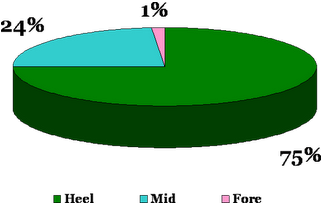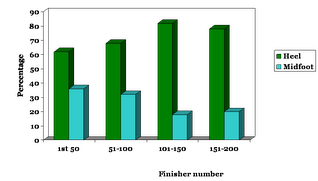Barefoot Running
Last year, in May, I ran my first half marathon in Sydney. It was also the first time I had seen barefoot runners in a race. Back then, I had just recently finished reading Born to Run by Christopher McDougall, a book that’s now widely credited to have started the trend in barefoot running. I remember Chris sent me an email just last October, when he contemplated joining the ranks of the Tarahumara tribe and asked me if it was a good idea to start with these sandals.. haha – he’s much bolder than I am!
I’m actually very fascinated by barefoot running. I know that it can help runners develop better form, alleviate certain types of running injuries, possibly improve running economy, and help develop speed. But, I also know that it gives rise to other types of running injuries and that, much like you have to find the right pair of running shoes to be able to run, not everyone can be a barefoot runner.
Most of the barefoot runners I’ve seen in races wear a pair of Vibram FiveFingers. They indicate on their site that their shoes are designed to promote a more efficient forefoot strike – that means, landing on the ball of your foot, closer to your toes. Note that most people naturally strike their heel or the middle of their foot when they run. Does it really matter? There’s been a lot of debate as to the efficiency of running with a forefoot strike vs. a mid-foot strike (vs. a heel strike!) Each one courts a different type of problem:
- If you land on your forefoot, that means that you’re putting your entire body weight on a contracted calf muscle about 100 times per minute for the duration of your workout (~100 for me, because I have a shorter stride). That means, if your average run is 30 minutes long, that’s 3,000 times you’re pushing your weight down on your calf muscles! That’s crazy!
- If you’re a mid-foot striker, you tend to have a better distribution of your weight when you land on your foot, but this doesn’t always work for everyone. It’s pretty unusual to just land mid-foot, because it doesn’t allow us to roll our feet to follow its natural gait.
- If you land on your heels, you could be over-stretching your calf muscles and can be at risk for over-striding. And just as landing mid-foot can inhibit natural pronation/supination – the same applies for heel striking!

Here’s a pretty awesome resource written by Ross Tucker. He summarizes the footstrike debate pretty well. I also totally dig this chart he used from a study published in 2007 in the Journal of Strength of Conditioning (Hasegawa et al., J Strength & Cond., 2007, (21), 888-893). Observing 248 men and 35 women, the Japanese looked at 21km elite runners and categorized their footstrikes: the vast majority land on their heels, followed by mid-strikers, and only 4 out of 283 were forefoot strikers. And you know what else they found? The athletes that finished ahead of the pack were a combination of heel and mid-foot strikers!
This chart on the left is also pretty interesting – when the finishers were divided into groups of 50, they found that there were more mid-foot strikers in the first 50 than in the rest of the other buckets! Hmm… I would’ve guessed that it’s because the faster we run, the more we shift our foot strike forward (ever notice that when you try to sprint, you run on your toes??) So it’s possible that most of the finishers probably land on their heels, but because speeding up entails a forward shift in our foot landing, a few of the finishers were inadvertently categorized as mid-strikers.
In any case, I need to do some additional research on ‘running form’ and footwear. There’s a correlation there, for sure. I’d like to start wearing more minimalist shoes, but I’ve also been trying to increase my miles recently. I would need to back off on that pretty significantly if I switch over to a pair of Nike Free shoes or a pair of BIKILA shoes. And I’m not sure I want to do that before my 2 half marathons that are coming up…
Related Posts



